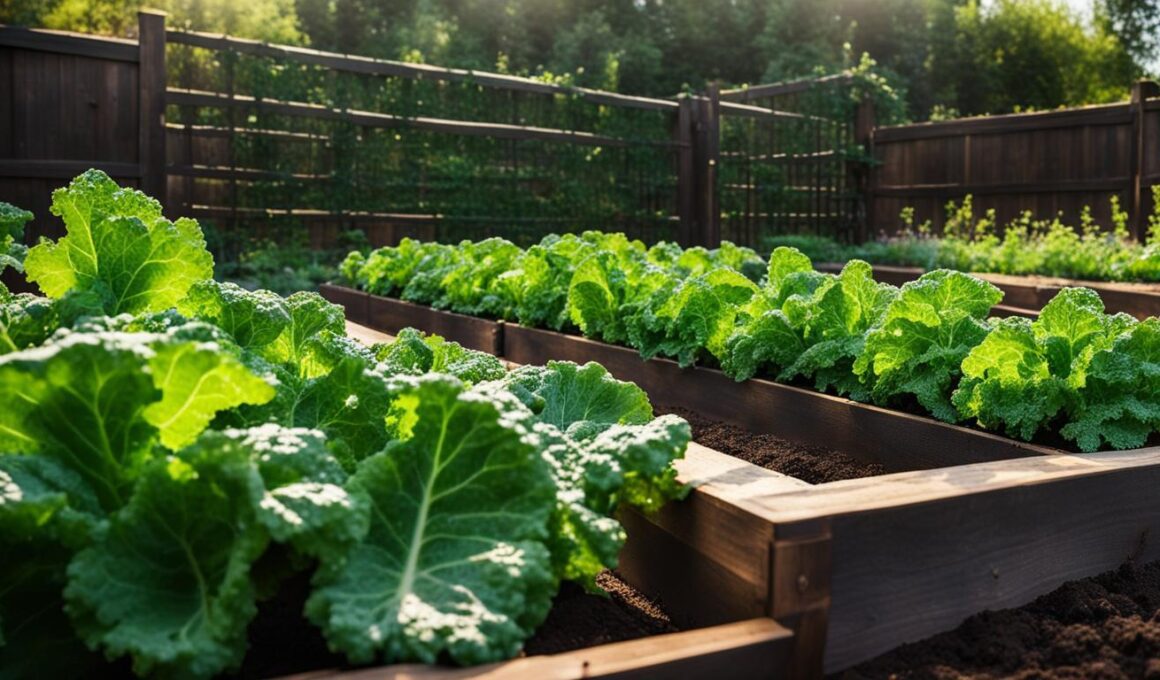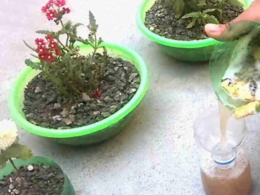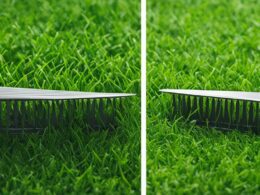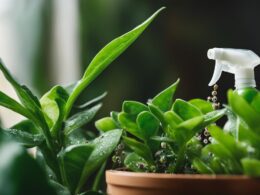Kale is a cold-hardy and resilient member of the cabbage family that can be easily grown in your garden. It can be planted in early spring and again in the fall for a second chance at a harvest. Kale is best grown in areas with cool weather and can be used in a variety of dishes, including salads, stir-fries, and smoothies.
Post Summary:- Growing kale in your garden can provide you with a bountiful harvest of this versatile vegetable.
- Kale is a cold-hardy plant that thrives in cool weather and can be planted in spring and fall.
- It’s important to provide kale with well-drained, fertile soil and regular watering.
- Regular care and pest control measures are necessary to ensure healthy kale plants.
- Harvest kale leaves when they reach the ideal size and store them properly for freshness.
When and Where to Plant Kale
If you’re planning to grow kale in your garden, it’s important to know when and where to plant it. Timing and location are crucial factors that can greatly impact the success of your kale crop. By following these gardening tips and creating ideal conditions, you can ensure your kale plants thrive and produce a bountiful harvest.
When it comes to planting kale, timing is key. For a spring harvest, it’s best to plant kale 3 to 5 weeks before the last frost. This will give the plants enough time to establish before the warmer weather sets in. If you’re aiming for a fall harvest, plant kale 6 to 8 weeks before the first fall frost. This allows the plants to mature and produce before the winter arrives.
As for the location, kale prefers full sun, which means it needs at least 6 hours of direct sunlight each day. Choose a spot in your garden that receives ample sunlight throughout the day. Additionally, kale thrives in well-drained, fertile soil with a pH of 6.5 to 6.8. You can improve the soil quality by adding aged compost or other organic matter. This will provide the necessary nutrients for the plants to grow and thrive.
| Spring Harvest | Fall Harvest | |
|---|---|---|
| Planting Time | 3 to 5 weeks before the last frost | 6 to 8 weeks before the first fall frost |
| Sunlight | Full sun (6+ hours per day) | Full sun (6+ hours per day) |
| Soil | Well-drained, fertile soil with pH 6.5 to 6.8 | Well-drained, fertile soil with pH 6.5 to 6.8 |
Whether you have an in-ground garden, raised beds, or containers, kale can be grown in various settings. Make sure to provide adequate space between plants to allow for proper air circulation and growth. Regular watering and feeding with plant food will help in maintaining optimal growth. With the right planting and care techniques, you’ll be on your way to a successful kale harvest.
Growing and Caring for Kale Plants
Once you have planted your kale, it’s important to provide regular care to ensure optimal growth. Here are some essential tips for growing and caring for your kale plants:
- Watering: Kale plants require consistent moisture to thrive. Water them regularly, providing about 1 to 1.5 inches of water per week. Make sure to water at the base of the plants to avoid wetting the leaves, which can lead to disease.
- Feeding: To promote healthy growth, apply a continuous-release plant food specifically formulated for vegetables. This will provide the necessary nutrients for your kale plants to flourish. Follow the product instructions for proper application.
- Indoor Growing: If you don’t have access to an outdoor garden, you can still grow kale indoors. Consider setting up a hydroponic growing system, which allows you to cultivate kale without soil. This method can be especially beneficial if you have limited space.
- Harvesting: As your kale plants mature, you can start harvesting the leaves. Begin by picking the lower leaves, allowing the upper leaves to continue growing. This will ensure a continuous harvest throughout the season.
By following these care tips, you’ll be well on your way to growing healthy kale plants in your garden or even indoors. Remember to monitor your plants regularly for signs of pests or diseases and take appropriate measures to address them promptly.
Keep in mind that kale is a resilient plant that can withstand cool weather and even a light frost. Its hardiness makes it an excellent choice for year-round cultivation in many climates.
Now that you have learned how to grow kale and care for your plants, let’s take a look at troubleshooting and pest control measures in the next section.
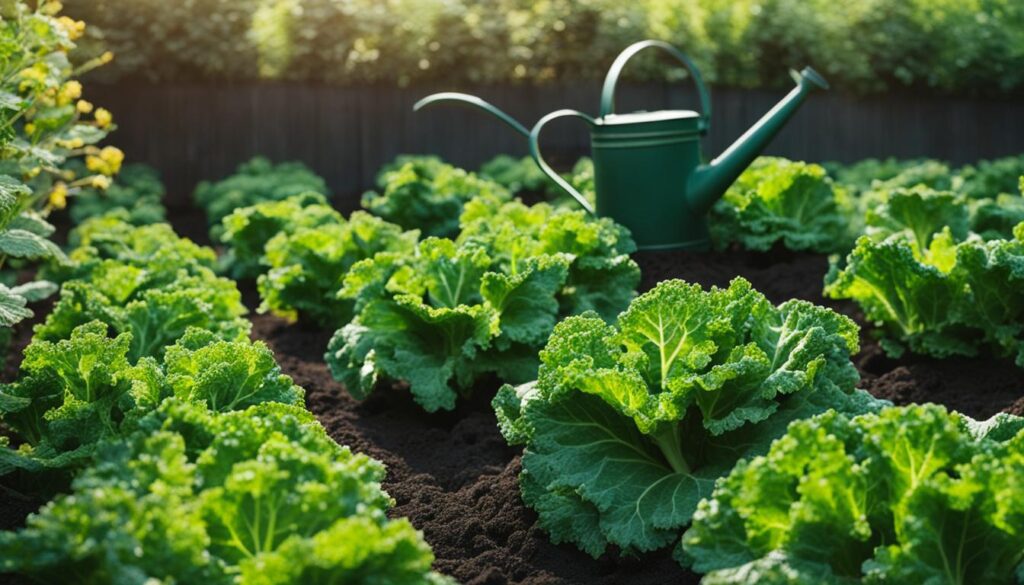
| Common Care Tips for Kale Plants | Benefits |
|---|---|
| Consistent watering | Prevents dehydration and promotes healthy growth |
| Feeding with continuous-release plant food | Provides essential nutrients for optimal development |
| Indoor growing | Allows for year-round cultivation in limited spaces |
| Harvesting lower leaves | Ensures continuous growth and harvest throughout the season |
Troubleshooting and Pest Control
Kale is a resilient and hardy plant, but it can still encounter common problems and pests that can impact its growth. By being aware of these issues and implementing proper pest control methods, you can ensure the health and productivity of your kale plants.
Common Problems
One common problem that kale plants may face is nutrient deficiency. This can manifest as yellowing or stunted growth. To address this issue, make sure your plants are receiving adequate nutrients by using a continuous-release plant food. Additionally, ensure that the soil pH is within the ideal range of 6.5 to 6.8 for optimal nutrient uptake.
Another problem that can affect kale is fungal diseases, such as powdery mildew or downy mildew. These diseases can cause white or grayish powdery growth on the leaves and can eventually lead to the death of the plant. To prevent fungal diseases, avoid overhead watering and provide proper spacing between plants to promote air circulation. If fungal diseases do occur, remove and dispose of affected leaves promptly.
Pest Control Methods
Kale can be targeted by a few common pests, including cabbageworms, aphids, and flea beetles. These pests can cause significant damage to the leaves, resulting in reduced yields. Fortunately, there are several pest control methods that you can employ to keep these pests at bay.
One effective method is to use row covers to physically prevent pests from reaching the plants. Row covers are lightweight fabrics that can be placed over the plants, creating a physical barrier. This method is particularly useful for preventing cabbageworms and flea beetles from accessing the leaves.
If pests do manage to find their way onto your kale plants, you can use insecticidal soap to control them. Insecticidal soap is a natural, low-toxicity pesticide that targets soft-bodied insects like aphids. Simply spray the soap solution onto the affected plants, making sure to thoroughly cover both the tops and bottoms of the leaves.
Another pest control method is companion planting. Certain herbs and flowers, such as marigolds and nasturtiums, can act as natural repellents for pests. Planting these companion plants alongside your kale can help deter pests and reduce damage.
| Pest | Damage | Pest Control Methods |
|---|---|---|
| Cabbageworms | Eat holes in the leaves | Use row covers, handpick and remove affected leaves |
| Aphids | Suck sap from the leaves | Apply insecticidal soap, attract beneficial insects |
| Flea Beetles | Create small holes in the leaves | Use row covers, apply insecticidal soap |
Regular inspection of your kale plants is crucial for early pest detection. By promptly addressing any pest issues and implementing effective pest control methods, you can protect your kale plants and ensure a successful harvest.
Harvesting and Storing Kale
Once your kale plants have reached the ideal size and color, it’s time to start harvesting. To ensure the continued growth of the plant, it’s important to pick the leaves in a specific way. Begin by selecting the lower leaves, starting from the outermost part of the plant and working your way inward. It’s recommended to leave at least four leaves intact at the top of each plant to ensure that it continues to grow and produce more leaves.
When harvesting kale, it’s important to handle the leaves with care to prevent bruising or damage. To do this, gently hold the stem with one hand and use your other hand to snap off the leaf at the base, where it meets the stem. This method allows for easy removal of the leaves without causing harm to the plant.
Once you’ve harvested your kale, it’s essential to store it properly to maintain its freshness and quality. One common method is to place the unwashed leaves in a plastic bag and store it in the refrigerator. This will help to keep the leaves crisp and prevent them from wilting. However, it’s important to note that kale should not be stored for more than a week, as it may begin to lose its nutritional value and flavor.
If you want to preserve your kale for a longer period, freezing is a great option. To freeze kale, begin by blanching the leaves in boiling water for 2-3 minutes, then transfer them to an ice bath to stop the cooking process. Once cooled, pat dry the leaves and place them in a freezer-safe bag or container. Be sure to remove as much air as possible to prevent freezer burn. Frozen kale can be stored for up to 10-12 months, allowing you to enjoy the nutritional benefits of kale all year round.
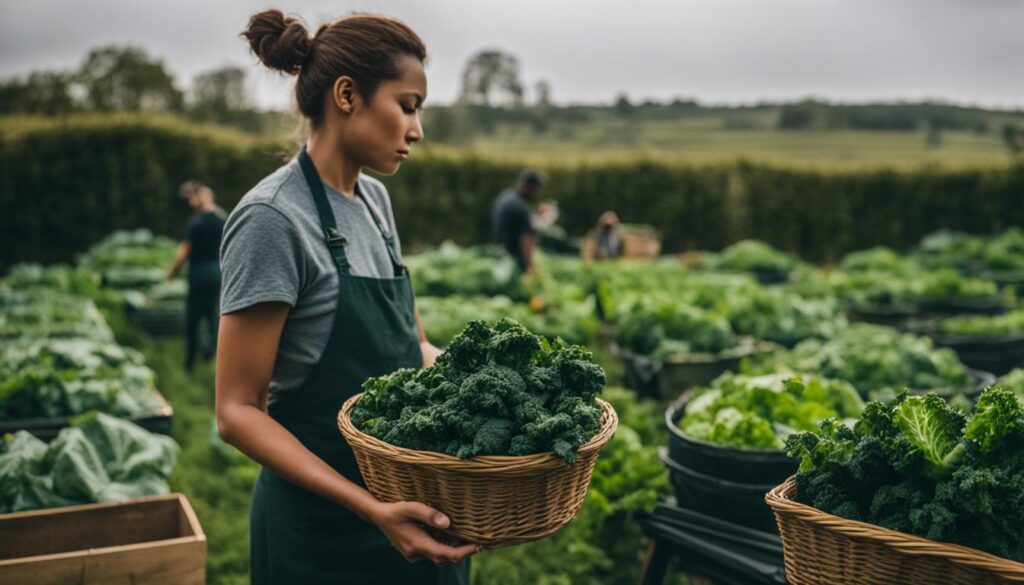
Comparison of Kale Storage Methods
| Storage Method | Duration | Considerations |
|---|---|---|
| Refrigerator | Up to 1 week | Keep kale in a plastic bag to maintain crispness. |
| Freezing | 10-12 months | Blanch kale before freezing to preserve color and texture. |
Can I Use My Backyard Ice Rink to Grow Kale?
With the right backyard ice rink setup tips, you can transform your icy patch into a thriving kale garden. By strategically positioning your kale beds and ensuring adequate sunlight, your backyard can be a dual-purpose space for both frosty fun and nutritious greens. Embrace the versatility of your backyard ice rink and nurture delicious kale right outside your door.
Conclusion
Growing kale in your garden can provide you with a bountiful harvest of this nutritious vegetable. By following the proper planting and care techniques discussed in this article, you can enjoy a successful kale-growing experience. Remember to plant kale in the right season, provide it with adequate sunlight and well-drained soil, and regularly water and feed the plants.
Monitoring for pests and implementing pest control methods will help protect your kale plants from common issues. Regularly inspecting your plants and harvesting the lower leaves as they mature will ensure continuous growth. Storing kale properly in the refrigerator or freezing it for longer-term freshness will allow you to enjoy its nutritional benefits over an extended period.
In summary, kale is a cold-hardy and versatile vegetable that can thrive in your garden. With its numerous health benefits and culinary uses, it’s a great addition to any garden. So why not give it a try? Start growing your own kale and enjoy the satisfaction of harvesting and cooking with this nutrient-packed leafy green!
FAQ
When is the best time to plant kale?
Kale can be planted 3 to 5 weeks before the last frost in spring or 6 to 8 weeks before the first fall frost for a fall harvest.
What are the ideal growing conditions for kale?
Kale prefers full sun and well-drained, fertile soil with a pH of 6.5 to 6.8.
Can kale be grown in containers?
Yes, kale can be grown in in-ground gardens, raised beds, and containers.
What is the best way to care for kale plants?
Kale plants should be watered consistently, with about 1 to 1.5 inches of water per week, and fed with a continuous-release plant food for optimal growth.
How can I protect my kale plants from pests?
Pests such as cabbageworms, aphids, and flea beetles can be controlled by using row covers, applying insecticidal soap, and planting companion plants.
When should kale leaves be harvested?
Kale leaves should be harvested when they reach the ideal size and color. The lower leaves can be picked first, leaving at least 4 leaves intact at the top of each plant.
How long can kale be stored?
Kale can be stored in a plastic bag in the refrigerator for up to a week. Freezing kale is also an option to preserve its freshness for a longer period.





